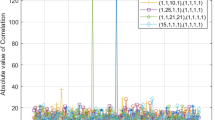Abstract
Narrowband Internet of Things (NB-IoT) is a Quasi-5G technology that will provide coverage for massive number of low-power consumption applications. Hence, the potential massive random access (RA) users call for a new RA scheme. In this paper, based on the key ideas of non-orthogonal multiple access and successive interference cancellation, the NB-IoT non-orthogonal random access (NB-NORA) scheme has been proposed to provide a more effective access performance for NB-IoT system. Further, the RA preamble (MSG1) transmission collision probability and initial layer 3 message (MSG3) outage performances are analyzed based on stochastic geometry, which is compared with the traditional NB-IoT orthogonal random access (NB-ORA) scheme. Simulation results show that the maximum throughput of MSG1 within NB-NORA scheme is double that within NB-ORA scheme, and the successful RA probability of NB-NORA is increased by about 75%.






Similar content being viewed by others
References
GPP.TR 38.913 v.14.2.0. (2017). Study on scenarios and requirements for next generation access technologies.
ITU Doc.5D/TEMP/300-E, Minimum Requirements Related to Technical Performance for IMT-2020 Radio Interface(s), http://www.itu.int/pub/R-REP-M.2134-2008,2017.
GPP.TS 36.211 v.14.2.0. (2017). Evolved universal terrestrial radio access (E-UTRA): Physical channels and modulation.
Rohde & Schwarz. (2016). Narrowband internet of things whitepaper. White paper.
Ratasuk, R., Vejlgaard, B., Mangalvedhe, N., et al. (2016). NB-IoT system for M2M communication. In Wireless Communications and networking conference (pp. 428–432). IEEE. https://doi.org/10.1109/wcnc.2016.7564708.
Chen, M., Miao, Y., Hao, Y., et al. (2017). Narrow band internet of things. IEEE Access,5(99), 20557–20577.
Chen, M., Miao, Y., & Hao, Y., et al. (2016). Technical specification group radio access network; evolved universal terrestrial radio access (E-UTRA); physical channels and modulation; (Release 13),” TS 36.211 V13.2.0.
Jiang, N., Deng, Y., Condoluci, M., et al. (2018). RACH preamble repetition in NB-IoT network. IEEE Communications Letters,22(6), 1244–1247. https://doi.org/10.1109/lcomm.2018.2793.274.
Kim, T., Han, S. J., & Han, K. S. (2015). An enhanced random access scheme with spatial group based reusable preamble allocation in cellular M2M networks. IEEE Communications Letters,19(10), 1714–1717. https://doi.org/10.1109/LCOMM.2015.2473860.
Benjebbovu, A. et al. (2013). System-level performance of downlink NOMA for future LTE enhancements. In: Proceedings of IEEE Globlecom workshop, Atlanta (pp. 66–70).
Kim, B. et al. (2013). Non-orthogonal multiple access in a downlink multiuser beamforming system. In Proceedings of IEEE Military Communication Conference, San Diego, CA (pp. 1278–1283).
Sedaghat, M. A., & Müller, R. R. (2018). On user pairing in uplink NOMA. IEEE Transactions on Wireless Communications,17(5), 3474–3486. https://doi.org/10.1109/TWC.2018.2815005.
Zhang, N., Wang, J., Kang, G., et al. (2016). Uplink nonorthogonal multiple access in 5G systems. IEEE Communications Letters,20(3), 458–461. https://doi.org/10.1109/LCOMM.2016.2521374.
Liang, Y., Li, X., Zhang, J., et al. (2017). Non-orthogonal random access (NORA) for 5G networks. IEEE Transactions on Wireless Communications,16(7), 4817–4831. https://doi.org/10.1109/TWC.2017.2703168.
Seo, J. B., Bang, C. J., & Hu, J. (2018). Non-orthogonal random access for 5G mobile communication systems. IEEE Transactions on Vehicular Technology,67(8), 7867–7871. https://doi.org/10.1109/TVT.2018.2825462.
Stefania, S., Issam, T., & Matthew, B. (2011). LTE—The UMTS long term evolution: From theory to practice. Hoboken, NJ: Wiley.
Kim, T., Bang, I., & Dan, K. S. (2017). An enhanced PRACH preamble detector for cellular IoT communications. IEEE Communications Letters,21(12), 2678–2681. https://doi.org/10.1109/LCOMM.2017.2745543.
Goldsmith, A. (2005). Wireless communications. Cambridge: Cambridge Univ. Press.
Funding
This work was supported by the National Natural Science Foundation of China (Grant No. 61701063) and China Scholarship Council.
Author information
Authors and Affiliations
Corresponding author
Additional information
Publisher's Note
Springer Nature remains neutral with regard to jurisdictional claims in published maps and institutional affiliations.
Appendix
Appendix
1.1 NB-NOMA System Model [13]
We assume a single-cell uplink transmission scenario, inwhich the evolved NodeB (eNB) is loacted at the center of the cell. The channel between the mth terminal and the eNB is denoted by \(h_{m}\) and \(h_{m} = \frac{{g_{m} }}{{l_{m} }}\), where \(l_{m}\) and \(g_{m}\) denotes pathloss and Rayleigh fading channel gain, respectively. To simplify the analysis, \(l_{m}\) is modelled by Free-Space path loss model [18], i.e., \(l_{m} = \left( {\frac{{\sqrt {G_{l} } \lambda }}{4\pi d}} \right)\), where \(G_{l}\) is the product of the transmit and receive antenna field radiation patterns in the line-of-sight (LOS) direction, and \(\lambda\) is the signal weave-length and \(d\) denotes the distance between terminal and eNB. The probability density function (PDF) of \(\left| {g_{m} } \right|^{2}\) can be written as
where \(\mu\) is the variance of the normal distribution \(N(0,\mu )\). Assuming that there are \(M\) terminals sharing the same uplink channel simultaneously, the received signal at eNB is given by
where \(p_{i}\) and \(s_{i}\) are the transmit power and transmit messages from the ith terminal, respectively. \(n\) denotes the additive noise at eNB. In order to split the overlapped signals, SIC receiver is carried out at eNB. Before eNB detects the mth terminal’s message, it decodes the prior ith \((i < m)\) terminals’ message first, then remove the message from its observation, in a successive manner. The rest (M-m) terminals’ messages are regarded as interferences. As a result, the achievable data rate of the mth terminal is
Assuming \(\hat{R}_{m}\) is the target data rate of the mth terminal, then the event that eNB successfully detects the mth terminal’s message can be defined as
Note that the pre-condition of (13) is \(R_{m} \ge \hat{R}_{m} (i < m)\) i.e., eNB needs to correctly decode the prior \((m - 1)\) terminals’ messages before detecting the mth terminal’s message, where \(R_{i}\) and \(\hat{R}_{i}\) are the achievable data rate and the target data rate of the ith terminal, respectively.
Rights and permissions
About this article
Cite this article
Wang, D., Qu, Y., Fu, Y. et al. A Non-orthogonal Random Access Scheme Based on NB-IoT. Wireless Pers Commun 111, 2625–2639 (2020). https://doi.org/10.1007/s11277-019-07006-5
Published:
Issue Date:
DOI: https://doi.org/10.1007/s11277-019-07006-5




